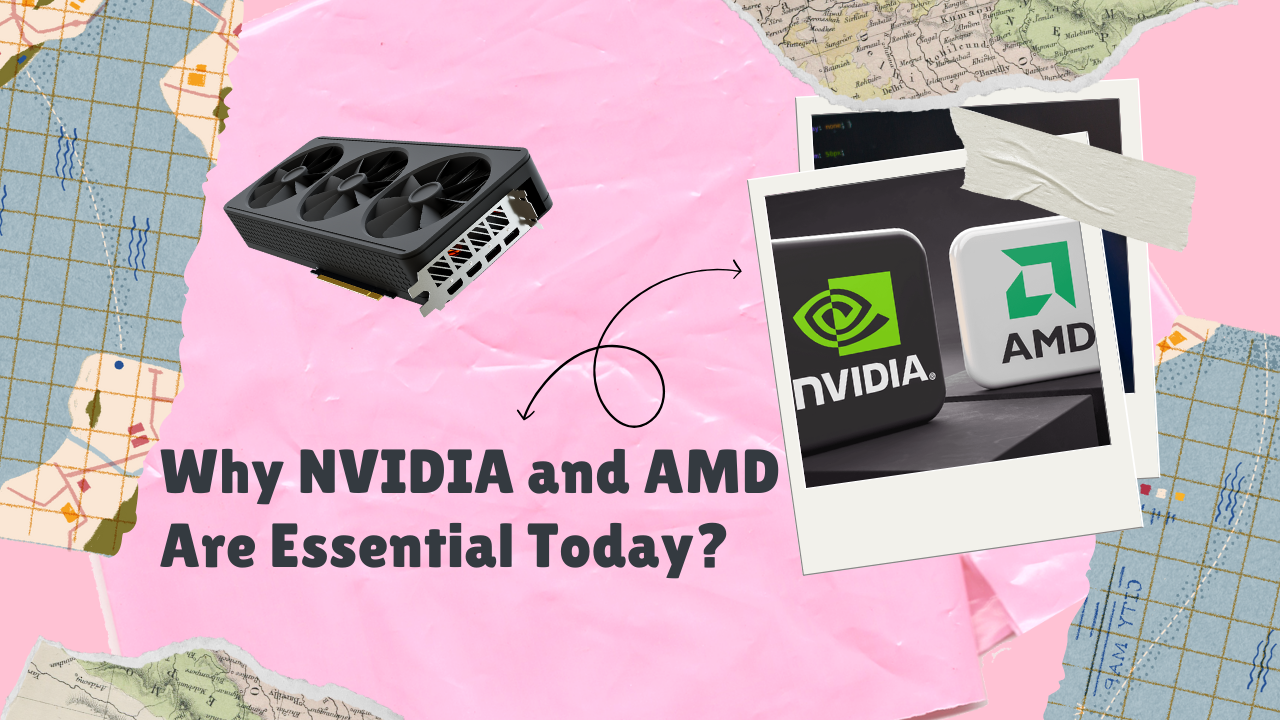Why NVIDIA and AMD Are Essential Today?
 Aakashi Jaiswal
Aakashi Jaiswal
In the fast moving world of tech, NVIDIA and AMD have emerged as indispensable players. Their contributions span across multiple industries, from gaming and artificial intelligence (AI) to data centers and automotive technologies. Understanding why these companies are so crucial today requires exploring their innovations, market influence, and the transformative impact of their products on both consumers and industries.
The Role of GPUs in Modern Computing

Graphics Processing Units (GPUs) are at the heart of NVIDIA and AMD's success. Originally designed for rendering graphics in gaming, GPUs have evolved into powerful tools for parallel computing, enabling breakthroughs in AI, machine learning, scientific research, and more. Unlike traditional CPUs, GPUs excel at processing multiple tasks simultaneously, making them ideal for handling complex computations efficiently.
NVIDIA pioneered this transformation by making GPUs programmable, opening up new possibilities beyond graphics rendering. This innovation laid the foundation for modern AI applications, where GPUs are used to train deep learning models that power technologies like natural language processing and computer vision.
AMD has also played a pivotal role in advancing GPU technology. Its Radeon GPUs offer competitive alternatives to NVIDIA’s products, driving healthy competition that fosters innovation. Moreover, AMD's integration of CPUs and GPUs in gaming consoles like PlayStation 5 and Xbox Series X underscores its significance in shaping the gaming industry.
Gaming: A Core Market for NVIDIA and AMD

Gaming remains one of the most prominent areas where NVIDIA and AMD shine. Both companies have revolutionized gaming experiences by delivering high-performance GPUs capable of rendering lifelike graphics and supporting immersive gameplay. NVIDIA’s GeForce RTX series introduced real-time ray tracing and AI-powered features like DLSS (Deep Learning Super Sampling), which enhance visual fidelity while maintaining high frame rates.
AMD’s Radeon RX series competes fiercely with NVIDIA’s offerings, providing gamers with powerful yet cost-effective solutions. The rivalry between these two giants has driven continuous advancements in GPU technology, benefiting gamers worldwide by pushing the boundaries of performance and affordability.
Beyond hardware, these companies have also influenced game development. Their technologies enable developers to create visually stunning games that leverage advanced lighting, physics simulations, and AI-driven interactions. As gaming continues to grow as a global entertainment medium, NVIDIA and AMD remain integral to its evolution.
Artificial Intelligence: Powering the Future
AI has become one of the most transformative technologies of our time, and NVIDIA stands at the forefront of this revolution. Its GPUs are widely used in AI research and applications, from training large language models to powering autonomous systems. The company’s CUDA platform has become a standard for GPU programming in AI development.

NVIDIA’s recent innovations include Tensor Cores designed specifically for AI workloads, enabling faster computations for deep learning tasks. These advancements have made NVIDIA GPUs indispensable for industries ranging from healthcare to finance and autonomous vehicles.
AMD is also expanding its presence in the AI space with its Instinct GPUs and EPYC processors optimized for data centers. The upcoming MI350 series promises to challenge NVIDIA’s dominance by offering competitive performance for AI server applications. As AI continues to reshape industries, both companies are driving its adoption by providing the computational power needed for innovation.
Data Centers: The Backbone of Modern Infrastructure

The demand for high-performance computing in data centers has skyrocketed due to the proliferation of cloud services, big data analytics, and AI applications. NVIDIA’s Tesla and A100 GPUs are widely deployed in data centers to accelerate workloads ranging from scientific simulations to real-time analytics.
AMD’s EPYC processors offer a compelling alternative with their focus on energy efficiency and scalability. By combining CPUs with GPUs optimized for server environments, AMD provides solutions tailored to the needs of modern data centers. These contributions are critical as businesses increasingly rely on robust infrastructure to support their operations.
Automotive Industry: Driving Innovation
The automotive sector is undergoing a technological transformation with the advent of autonomous vehicles. NVIDIA’s DRIVE platform leverages its expertise in AI and GPU computing to provide advanced solutions for self-driving cars. From sensor fusion to decision-making algorithms, NVIDIA’s technology is helping shape the future of mobility.
AMD is also making strides in this space through collaborations with companies like Tesla. Its processors play a key role in powering infotainment systems and enabling real-time processing capabilities essential for autonomous driving. As vehicles become smarter and more connected, both companies will remain central to this evolution.
Social Impact: Beyond Gaming and AI
The influence of NVIDIA and AMD extends beyond their core markets. Their technologies are being used in groundbreaking projects like NASA’s climate modeling simulations and astronomy initiatives such as the Square Kilometre Array telescope. These applications highlight how GPUs contribute to solving global challenges by enabling faster computations and more accurate predictions.
Additionally, both companies are driving sustainability efforts by improving energy efficiency in their products. As industries strive to reduce their carbon footprint, innovations from NVIDIA and AMD play a crucial role in achieving greener computing solutions.
Competition Fuels Innovation
The ongoing rivalry between NVIDIA and AMD is a testament to the importance of competition in driving technological progress. While NVIDIA dominates many markets with its cutting-edge innovations, AMD continues to challenge its position by offering high-performance products at competitive prices.
This dynamic competition benefits consumers by ensuring continuous advancements in performance, affordability, and accessibility. Whether it’s gamers seeking immersive experiences or researchers needing powerful tools for complex computations, both companies cater to diverse needs while pushing the boundaries of what is possible.
Why They Matter Today
NVIDIA and AMD are not just tech companies; they are catalysts for innovation across industries. Their contributions have shaped modern computing by enabling breakthroughs in gaming, AI, data centers, automotive technologies, and more. As we move into an era defined by digital transformation, their role will only grow more significant.
From enhancing entertainment experiences to solving global challenges through computational power, these companies exemplify how technology can drive progress. Whether you’re a gamer enjoying lifelike graphics or a scientist unraveling cosmic mysteries with advanced simulations, chances are you’re benefiting from the innovations brought forth by NVIDIA or AMD.
Their importance lies not only in what they’ve achieved but also in their potential to shape the future. As they continue to push technological boundaries, they remain essential players in building a smarter, more connected world where possibilities are limitless.
Subscribe to my newsletter
Read articles from Aakashi Jaiswal directly inside your inbox. Subscribe to the newsletter, and don't miss out.
Written by

Aakashi Jaiswal
Aakashi Jaiswal
Coder | Winter of Blockchain 2024❄️ | Web-Developer | App-Developer | UI/UX | DSA | GSSoc 2024| Freelancer | Building a Startup | Helping People learn Technology | Dancer | MERN stack developer